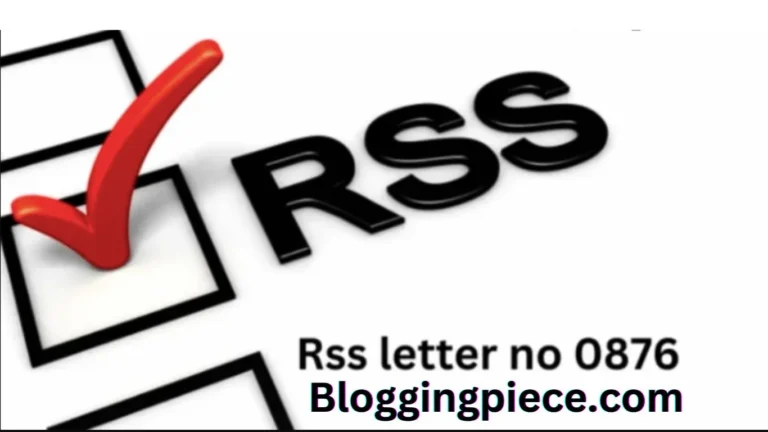Introduction
Navigating the world of regulatory and compliance documents can be daunting, especially when dealing with specifics like RSS Letter No 0876. This guide aims to demystify this particular RSS (Regulatory Safety Standard) letter, providing a clear, detailed explanation of its content, implications, and relevance. Whether you’re a compliance officer, a business owner, or just a curious individual, this article will equip you with the essential information you need.
What is RSS Letter No 0876?
RSS Letter No 0876 is a crucial document issued as part of regulatory safety standards. To fully grasp its importance, it’s helpful to understand the general concept of RSS letters. These documents are designed to communicate specific regulatory requirements and safety protocols that organizations must adhere to.
Overview of RSS Letters
RSS letters are formal communications from regulatory bodies that outline mandatory compliance standards and safety guidelines. They often serve as a means to ensure that industries are operating within the legal and safety parameters established by governing authorities.
Specifics of Letter No 0876
Letter No 0876 addresses particular safety concerns and compliance requirements. It includes detailed guidelines on various aspects that organizations must follow to ensure they meet the prescribed safety and operational standards.
The Importance of RSS Letter No 0876
Understanding the importance of RSS Letter No 0876 is key to appreciating its impact on regulatory compliance.
Regulatory Context
This letter is part of a broader regulatory framework designed to enhance safety and operational efficiency. It reflects updates or changes in safety standards that organizations need to implement to maintain compliance with industry regulations.
Compliance Requirements
Compliance with RSS Letter No 0876 involves adhering to the specific guidelines outlined in the document. Non-compliance can result in significant penalties, legal issues, and potential safety risks.
Key Sections of RSS Letter No 0876
The letter is structured into several sections, each addressing different aspects of safety and compliance.
Section 1: General Guidelines
This section provides an overview of the fundamental requirements and expectations outlined in the letter. It sets the stage for understanding the more detailed guidelines in the subsequent sections.
Section 2: Safety Protocols
Here, the letter details specific safety measures and protocols that organizations must implement. This section is crucial for ensuring that all safety standards are met and maintained.
Section 3: Implementation Procedures
The final section focuses on the steps and procedures for implementing the guidelines. It includes practical advice on how to integrate the requirements into everyday operations.
How to Interpret RSS Letter No 0876
Interpreting regulatory documents can be challenging due to the technical language and specific jargon used.
Understanding Regulatory Jargon
Regulatory documents often use specialized terms and phrases that can be difficult to decipher. Familiarizing yourself with these terms is essential for accurate interpretation and compliance.
Common Misinterpretations
Certain phrases or sections might be misinterpreted, leading to incorrect implementations. It’s important to thoroughly review the letter and seek clarification if needed to avoid such issues.
Impact on Businesses
RSS Letter No 0876 has various implications for businesses, depending on their industry and operations.
Industry-Specific Implications
Different industries may be affected in unique ways. For example, manufacturing might have different compliance requirements compared to the healthcare sector. Understanding these nuances is crucial for effective compliance.
Case Studies of Compliance and Non-Compliance
Reviewing real-world examples of how businesses have handled the letter’s requirements can provide valuable insights. Case studies highlight both successful compliance and the consequences of failing to meet the standards.
Steps for Compliance
To ensure compliance with RSS Letter No 0876, organizations need to follow specific steps.
Preparing for Implementation
Preparation involves reviewing the letter in detail, assessing current practices, and identifying areas that need adjustment to meet the new requirements.
Documentation and Reporting
Maintaining proper documentation and reporting is essential for demonstrating compliance. This includes keeping records of implemented changes and any communications related to compliance efforts.
Common Challenges and Solutions
Compliance with regulatory standards can present various challenges.
Technical and Administrative Hurdles
Organizations might face technical difficulties or administrative obstacles in implementing the letter’s requirements. Identifying these challenges early on can help in developing effective solutions.
Best Practices for Overcoming Challenges
Implementing best practices can streamline the compliance process. This includes training staff, utilizing technology for better management, and seeking expert advice when necessary.
Conclusion
RSS Letter No 0876 is a vital component of regulatory compliance, ensuring that organizations maintain high safety and operational standards. By understanding its content, interpreting it correctly, and implementing the required changes, businesses can avoid potential pitfalls and align with regulatory expectations.
FAQs About RSS Letter No 0876
-
What is the main purpose of RSS Letter No 0876?
RSS Letter No 0876 aims to ensure that organizations adhere to updated safety and regulatory standards.
-
Who needs to comply with this letter?
Organizations within the scope of the regulatory body issuing the letter are required to comply.
-
What are the consequences of non-compliance?
Non-compliance can lead to legal penalties, fines, and potential safety risks.
-
How can I find more detailed information about the letter?
Consult the regulatory body’s official website or seek guidance from a compliance expert.
-
Are there resources available for better understanding the letter?
Yes, various resources, including official guidelines and expert consultations, can provide further clarification.


